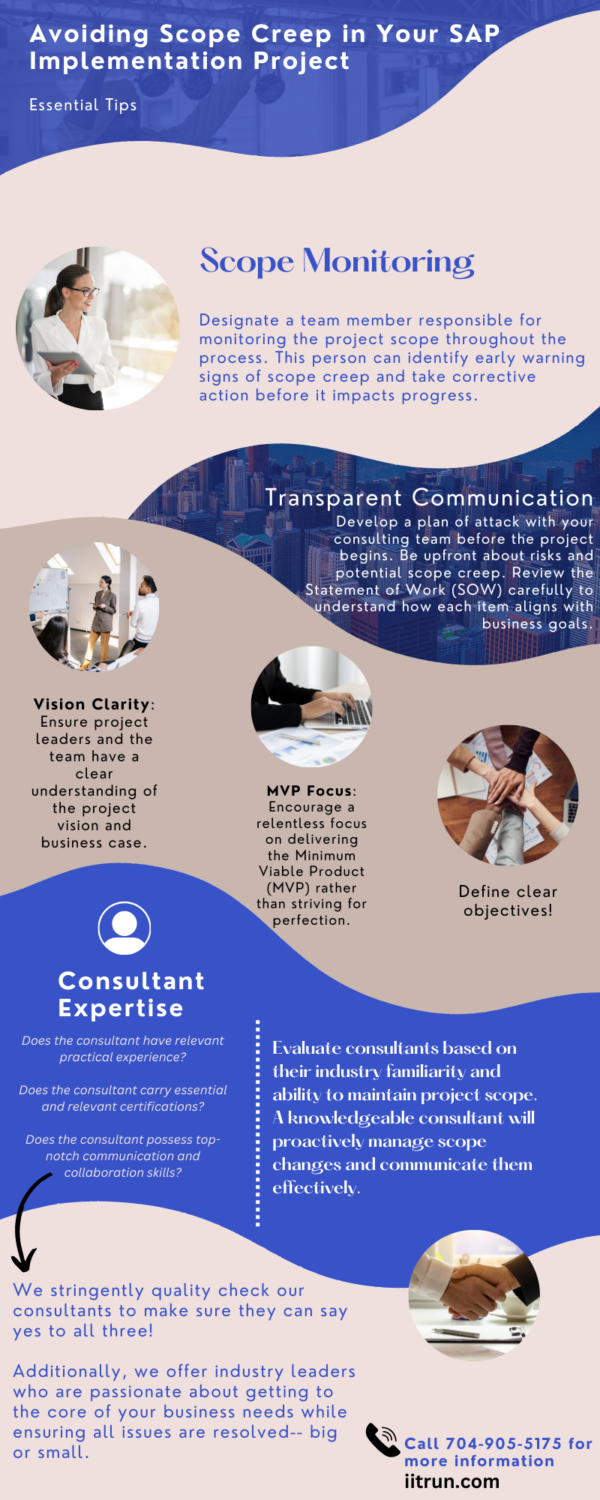A study by Komal and other authors delves into the profound effects of scope creep on the success of software projects, revealing key insights crucial for project management.1 Overall, the study found that scope creep is a common culprit for software project failures. The repercussions included compromised quality, delayed schedules, increased costs, and diminished customer satisfaction.
To comprehensively explore scope creep factors, the study employed both a Systematic Literature Review (SLR), and expert interviews to garner insights from industry specialists. They found that key factors contributing to said scope creep included poorly defined scope, schedule constraints, and requirement volatility.
Additionally, they defined three major components to scope creep: technological, organizational, and human. The study emphasizes the importance of addressing these factors to mitigate the adverse consequences of scope creep and reduce project failure rates in the software industry, providing valuable insights for practitioners.
To help with this issue, the study offers practical advice. For instance, it urges a deep understanding of the factors contributing to scope creep. This knowledge empowers project teams to proactively address potential issues, preventing uncontrolled scope expansions. Additionally, the study advocates for the implementation of robust control strategies, emphasizing regular reviews and approvals of scope changes, clear establishment and monitoring of scope baselines, and open stakeholder communication to manage expectations promptly.
Mitigation measures are also emphasized, encouraging risk assessment and management, change impact analysis to evaluate modifications’ effects on project objectives, and prioritization of scope items based on business value and criticality. By adopting these effective control and mitigation strategies, the study asserts that project success rates can be significantly improved, positively influencing customer satisfaction, on-time delivery, and budget adherence when scope creep is managed effectively.
With this information in mind, let’s assess scope creep itself.
 The Nature of Scope Creep
The Nature of Scope Creep
A research study conducted by Maeresera delves into the intricacies of dealing with scope creep in e-commerce projects.2
The study aimed to shed light on gaps in scope management contributing to the notorious scope creep. A key revelation was the varying understanding and expectations among developers, project managers, clients, and stakeholders, creating a void in effective scope management. The study explores how this disconnect becomes a breeding ground for scope creep, exacerbated by clients grappling to articulate their needs fully until the project kicks off.
As the e-commerce landscape evolves rapidly, so too must the strategies for managing changes within project scopes. The study outlines the fundamental need to adhere to the defined scope, emphasizing the importance of meticulous recording, time adjustments, and transparent communication. Additionally, it delves into the unique challenges of e-commerce projects, where clients, driven by the desire to outperform competitors, demand features without a complete understanding of scoping intricacies. In response, the study advocates for proactive control measures to navigate the intricate nature of these projects successfully.
The study also explores the objective of identifying preventable causes of scope creep that project managers and stakeholders should address before project commencement. It highlights how a lack of comprehensive understanding among project managers of the e-commerce platform, IT development, and crucial business aspects can create hurdles. Additionally, clients seeking to outdo competitors may inadvertently push projects to start without a complete scope. Recognizing and proactively addressing these issues emerges as a crucial step in preventing scope creep in e-commerce projects.
Based on questionnaire responses, the study reveals inherent challenges in managing scope for creative e-commerce projects. For instance, clients initially struggle to articulate their needs fully, contributing to scope creep as projects progress. Despite continuous collaboration, e-commerce projects among project managers and teams often lack uniformity, further complicating scope management. The compromised skill set in project management teams, stemming from differing perceptions and approaches, underscores the need for a more cohesive understanding of scope management’s impact on IT-related projects.
Finally, project managers, who according to literature linked in the study are responsible for 80% of scope failures, face an array of challenges surrounding scope creep. For instance, they bear the delicate task of balancing client demands within the project’s initial scope, fostering effective communication, and adeptly managing risks associated with scope changes. As a result, a successful project should focus on the needs and work quality of the project manager.
Overall, the study underscores the profound impact of scope creep on project dynamics, affecting timelines, budgets, and overall success. When unchecked, scope creep can lead to delays, heightened costs, and strained client relationships. Identifying various contributors to this phenomenon, the research unveils factors such as unclear requirements, misaligned stakeholder expectations, and the absence of effective change control processes.
By addressing these common factors, project teams can better navigate the challenges associated with scope creep in e-commerce projects.
 What Does This Mean?
What Does This Mean?
When implementing an Enterprise Resource Planning (ERP) system, businesses must remain vigilant against the pitfalls of scope creep, as it can significantly hinder the success of the project. Scope creep refers to uncontrolled changes or additions to the initial project scope, often driven by evolving requirements, stakeholder demands, or unforeseen challenges. This phenomenon can lead to an expansion of the project’s timeline and budget, preventing the project from managing resources effectively.
From the start of the project, the team needs to establish a well-defined and documented project scope. This initial scope acts as a guiding framework, outlining the objectives, deliverables, and boundaries of the ERP implementation. Clear communication of this scope to all stakeholders helps set expectations and minimizes the potential for misunderstandings or unauthorized changes.
Additionally, businesses should implement robust change management processes. Regularly reviewing and assessing proposed changes against the agreed-upon scope ensures that the team only approves necessary modifications. To do so, the team needs to evaluate the impact on the project timeline, budget, and resources before incorporating any alterations. A stringent change control mechanism acts as a safeguard, allowing businesses to maintain control over the project’s direction and preventing unauthorized deviations from the original plan.
Moreover, the project must foster effective communication among teams, stakeholders, and decision-makers. Open and transparent communication channels help identify potential scope creep early on, allowing for proactive resolution. Regular project updates, status reports, and team meetings provide opportunities to address concerns, discuss any proposed changes, and collectively decide on the best course of action to keep the project on track.
In summary, businesses embarking on ERP implementations should recognize the significance of controlling scope creep. By establishing a clear initial scope, implementing robust change management processes, and fostering transparent communication, organizations can mitigate the risks associated with uncontrolled changes, ensuring a more successful and streamlined ERP implementation.
Here are the specific steps businesses should take to avoid scope creep during ERP implementations:
- Define Clear Objectives: Start by outlining specific and measurable project objectives. Clearly articulate what you aim to achieve with your SAP implementation, ensuring alignment with overall business goals.
- Involve Stakeholders: Engage key stakeholders from various departments early in the planning phase. Their insights and requirements are crucial for creating a well-defined scope that accommodates diverse needs.
- Conduct Thorough Requirements Analysis: Conduct a meticulous analysis of business requirements. Clearly understand the functionalities needed, and document them comprehensively to set the boundaries of your project scope.
- Establish a Robust Change Control Process: Implement a structured change control process. Define how changes will be requested, evaluated, and approved. This ensures that any alterations to the initial scope undergo careful scrutiny.
- Document a Scope Baseline: Develop a detailed scope baseline that serves as a reference point throughout the project. This document should include the agreed-upon functionalities, features, and deliverables, providing a clear benchmark for scope control.
- Regularly Monitor Progress: Continuously monitor project progress against the established scope. Regularly assess whether the project is adhering to the initial scope and promptly address any deviations or potential scope creep.
- Communicate Transparently: Foster open and transparent communication among project teams. Ensure that all stakeholders are aware of the approved scope and any changes made. This reduces the likelihood of miscommunication leading to scope creep.
- Prioritize Deliverables: Prioritize project deliverables based on business value and criticality. Focus on essential functionalities first, ensuring that the core objectives are achieved before considering additional features.
- Educate Project Team: Provide comprehensive training to the project team about the importance of scope control. Ensure everyone understands the potential consequences of scope creep and the role they play in preventing it.
- Regularly Review and Evaluate: Schedule regular reviews to assess project progress, milestones, and scope adherence. Periodically evaluate whether the initial objectives are being met and adjust the scope only when absolutely necessary.
Conclusion
A common issue for businesses that implement not only SAP but ERP projects in general, scope creep can pose a significant threat. Fortunately, businesses can take preventative measures to ensure a smooth implementation.

1 B. Komal et al., “The Impact of Scope Creep on Project Success: An Empirical Investigation,” in IEEE Access, vol. 8, pp. 125755-125775, 2020, doi: 10.1109/ACCESS.2020.3007098. https://ieeexplore.ieee.org/abstract/document/9133081
2 Maeresera, S. Scope creep management challenges in an outsourced e-commerce project management company in Cape Town, in Cape Peninsula University of Technology, 2019. https://etd.cput.ac.za/handle/20.500.11838/3015


 While SAP is an excellent software option for many, businesses may grapple with common challenges that impede their journey towards seamless operations. One such hurdle is the phenomenon known as scope creep. As organizations embark on their SAP endeavors, understanding and mitigating scope creep becomes crucial for a successful implementation process.
While SAP is an excellent software option for many, businesses may grapple with common challenges that impede their journey towards seamless operations. One such hurdle is the phenomenon known as scope creep. As organizations embark on their SAP endeavors, understanding and mitigating scope creep becomes crucial for a successful implementation process.  The Nature of Scope Creep
The Nature of Scope Creep


